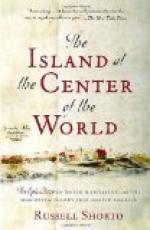[Illustration: Ferry-House on East River, 1746, from an Old Print.]
Even before this had happened in New York, the citizens of Boston had dumped a cargo of tea into their harbor, and the British Parliament had closed the port of Boston; which meant that no ships were permitted to sail in or out of it. By this it was hoped to stop all business in Boston, and really it did put an end to a great part of it. And General Thomas Gage, who now had charge of the British troops in America, undertook to see that the orders of the King were properly enforced.
This closing of the port of Boston aroused the thirteen British colonies in America. After a great deal of letter-writing it was decided to have men from each of these colonies meet and talk matters over. In September of this year (1774) they met in Philadelphia. At this meeting, which was called the First Continental Congress, it was decided that laws were made in England that were unjust to America, that the colonists objected to taxes that were fixed by Parliament and would buy no more goods from England while a tax was upon them; and that they objected to the support of a large British army in the colonies.
And this First Continental Congress sent a petition to King George III., saying that the unjust laws should be done away with.
How the King received this petition is soon told.
CHAPTER XXIII
The Sons of liberty at Turtle bay
Now in New York almost everybody was anxious to carry out the decision of this First Continental Congress.
But the Assembly said that the Congress had not been a lawful gathering and must not be obeyed. The colonists replied that they would do as they thought best, no matter what the King’s Assembly ordered.
You must know that some of the people supported the royal cause and were called Royalists or Tories. The others were called Patriots or Whigs. The English called the patriots rebels.
It had now come to be the year 1775, and matters in Boston where the port had been closed were growing worse and worse. In the month of April some British soldiers passing through Lexington shot down a number of patriots. Messengers on horseback sped through the colonies carrying news of this massacre. It was the first serious encounter of the Revolution and the colonists realized that they were now at war with the British. Men rushed to arms. Farmers left their homes. Professional men hurried from the towns. Within a few days an army surrounded Boston and penned in the British troops there.
When the messenger reached New York with the news of the Lexington massacre, a Provisional Assembly was formed which was to look after the city without regard to the Assembly which already existed. And this is the way it came about that there was a king’s government and a people’s government. Shops were closed and armed citizens paraded the streets. Matters went on in this fashion for a month, when a Second Continental Congress met at Philadelphia.




